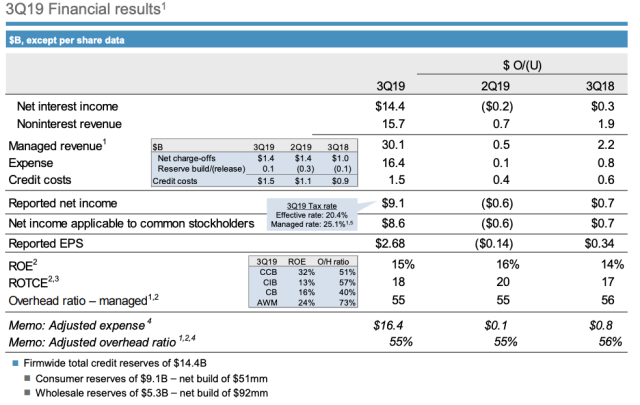JPMorgan kicked off a veritable deluge of bank earnings on Tuesday, beating on both the top and bottom lines.
Managed revenue was $30.1 billion, ahead of the $28.47 billion the street was looking for. The range there was $27.99 billion to $29.23 billion. Adjusted EPS came in at $2.68, handily beating consensus of $2.46 (range was $2.32 to $2.54). Net income was $9.1 billion.
NII looks like a beat, helping propel the shares higher in the premarket. In Q2, the bank cut its annual net interest income outlook to $57.5 billion.
Q1 was the high-water mark for Fed-assisted NII boosts.
After falling 3% in Q2, FICC sales and trading revenue was $3.56 billion in the third quarter. That is up 25% YoY, and well ahead of consensus, which was looking for $3.09 billion. “Markets performance was solid, reflecting improved client activity — particularly in Fixed Income”, Jamie Dimon remarked.
Rates volatility surged in August, when hedging flows exacerbated a growth-scare-induced plunge in yields. Markets were also forced to digest all manner of trade uncertainty that month.
Equities sales and trading revenue was $1.52 billion in Q3. That’s down 5.1% YoY, and trailed estimates.
Investment banking revenue was $1.87 billion up 8.1%. That too, is a beat. The estimate there was $1.8 billion. The bank cites higher debt and equity underwriting fees. “We had record third quarter IB fees with particularly strong performance in DCM and ECM, and year-to-date we maintained our #1 global ranking with share gains across products and regions”, Dimon boasted.
Commenting on the macro outlook, he said the US economy has slowed – albeit “slightly”.
“The consumer remains healthy with growth in wages and spending, combined with strong balance sheets and low unemployment levels”, he went on to say, adding an obligatory caveat about the deleterious impact of trade tensions. “This is being offset by weakening business sentiment and capital expenditures mostly driven by increasingly complex geopolitical risks, including tensions in global trade”.
All in all, it’s hard to see how this isn’t a good report. The shares were up handily.
Results
713c9e33-64d3-430d-92f3-91e5c7c0651f 45256e8f-40ab-4d40-bba3-4193e1577515







Too Big To Fail Banks (like Goldman and JPM) are still having trouble with long-term debt are reported relative to risk-weighted assets (RWA) — at least that’s what their SEC filings indicate, but help is on the way to help banks become riskier:
New watered down Dodd-Frank change: The Federal banking agencies (Federal Reserve, OCC, FDIC) jointly proposed to amend their capital rules to require certain large banking organizations to deduct from regulatory capital certain investments in unsecured debt instruments issued by foreign or U.S. global systemically important banking organizations (GSIBs) to meet their minimum Long Term Debt (LTD) or Total Loss Absorbing Capacity (TLAC) requirements (together Covered Debt).* Such investments in GSIB debt are presently subject to a risk-weight of 100 percent and are not deducted from regulatory capital. The proposed rule is intended to reduce interconnectedness and systemic risk. (how?)
“*”Covered Debt: Covered Debt subject to the deduction from regulatory capital would include eligible debt securities under the TLAC Rule that do not qualify as Tier 2 capital, and instruments that are pari passu or subordinated to such eligible securities, issued by the top-tier holding company of a U.S. GSIB or the top tier U.S. intermediate holding company (IHC) of a foreign GSIB …
https://advisory.kpmg.us/articles/2019/proposed-rule-on-tlac-debt-investments.html
Prior Dodd-Frank before trump admin: As shown in the table, Forum members are required to issue long-term debt in amounts between 8.0% and 13.4% of RWA, which compares to the total capital outstanding of Forum members that ranges between 15.2% and 21.6% of RWA. Accordingly, the long-term debt required by the TLAC rule is significant and makes an important contribution to the overall financial resilience of Forum members. The final column of the table reports the sum of long-term debt and equity capital or “Total Loss Absorbing Capacity,” which ranges between 23.9% and 34.9% of RWA. While total loss absorbing capacity is not directly comparable to equity capital, it does provide an appropriately broader measure of loss-bearing capacity that is informative about Forum members’ ability to withstand financial shocks.
https://www.fsforum.com/types/press/blog/total-loss-absorbency-and-financial-resiliency/